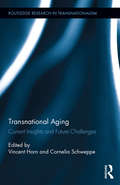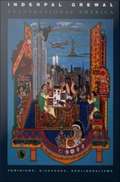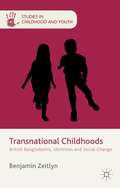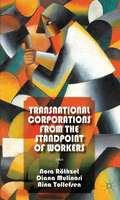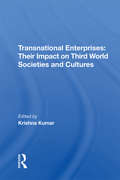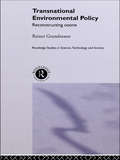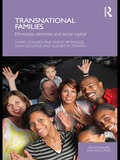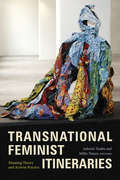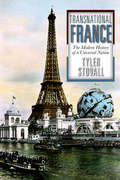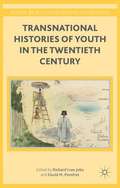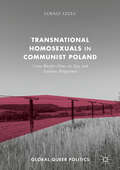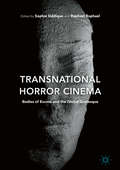- Table View
- List View
Transnational Advocacy Networks in the Information Society: Partners or Pawns? (Information Technology and Global Governance)
by Derrick L. CogburnThis book examines the role of transnational advocacy networks in enabling effective participation for individual citizens in the deliberative processes of global governance. Contextualized around the international conference setting of the United Nations-sponsored World Summit on the Information Society (WSIS) in 2003 and 2005, the book sees epistemic communities and information and communication technologies (ICTs) as critical to the effectiveness of this important organizational form. Historically, governments have dominated the official “conference diplomacy” surrounding these World Summits. However, reflecting the UN General Assembly resolution authorizing WSIS, transnational civil society and private sector organizations were invited to participate as official partners in a multistakeholder dialogue at the summit alongside the more traditional governments and international organizations. This book asks: are transnational advocacy networks active in the global information society influential partners in these global governance processes, or merely symbolic tokens—or pawns? Cogburn explores the factors that enabled some networks—such as the Internet Governance Caucus—to persist and thrive, while others failed, and sees linkages with epistemic communities—such as the Global Internet Governance Academic Network—and ICTs as critical to network effectiveness.
Transnational Agency and Migration: Actors, Movements, and Social Support (Routledge Research in Transnationalism)
by Wendy Smith Stefan KöngeterMigrants, both spatially and mentally, no longer settle in only one national territory but interact or move across borders regularly, profoundly challenging the nation-state and the image of society as a container. This volume explores the ways in which migrants, activists and professionals connect social worlds across national boundaries through a variety of social practices. The contributions from various disciplines - anthropology, economics, political and social sciences, educational studies and social work - illuminate the meaning of agency in situations where the capabilities of transnational actors are constrained by nation-states, their borders and social institutions. Based on a relational understanding of transnational agency which builds upon new insights and developments within transnational studies and network theory, this compilation of chapters presents transnational processes and developments in and across various regions of the globe - in East Asia, the Americas, the EU, Southeast Asia, Africa and Australia, in the borderlands of Mexico and the US, in the transatlantic space of the 19th-century fin de siècle world - in order to demonstrate the importance of gaining, assisting and expanding agency in transnational contexts.
Transnational Aging: Current Insights and Future Challenges (Routledge Research in Transnationalism)
by Vincent Horn Cornelia SchweppeThis book focuses on the diverse interrelationships between aging and transnationality. It argues that the lives of older people are increasingly entangled in transnational contexts on the social as well as the cultural, economic and political levels. Within these contexts, older people both actively contribute to and are affected by border-crossing processes. In addition, while some may voluntarily opt for adding a transnational dimension to their lives, others may have less choice in the matter. Transnational aging, therefore, provides a critical lens on how older people shape, organize and cope with life in contexts that are no longer bound to the frame of a single nation-state. Accordingly, the book emphasizes the agency of older people as well as the personal and structural constraints of their situations. The chapters in this book reveal these aspects by approaching transnational aging from different methodological angles, such as ethnographic research, comparative studies, quantitative data, and policy and discourse analysis. Geographically, the chapters cover a wide range of countries in Africa, Asia, Europe, North and South America, such as Namibia, Thailand, Russia, Germany, the United States and Ecuador.
Transnational America: Feminisms, Diasporas, Neoliberalisms
by Inderpal GrewalIn Transnational America, Inderpal Grewal examines how the circulation of people, goods, social movements, and rights discourses during the 1990s created transnational subjects shaped by a global American culture. Rather than simply frame the United States as an imperialist nation-state that imposes unilateral political power in the world, Grewal analyzes how the concept of "America" functions as a nationalist discourse beyond the boundaries of the United States by disseminating an ideal of democratic citizenship through consumer practices. She develops her argument by focusing on South Asians in India and the United States. Grewal combines a postcolonial perspective with social and cultural theory to argue that contemporary notions of gender, race, class, and nationality are linked to earlier histories of colonization. Through an analysis of Mattel's sales of Barbie dolls in India, she discusses the consumption of American products by middle-class Indian women newly empowered with financial means created by India's market liberalization. Considering the fate of asylum-seekers, Grewal looks at how a global feminism in which female refugees are figured as human rights victims emerged from a distinctly Western perspective. She reveals in the work of three novelists who emigrated from India to the United States--Bharati Mukherjee, Chitra Banerjee Divakaruni, and Amitav Ghosh--a concept of Americanness linked to cosmopolitanism. In Transnational America Grewal makes a powerful, nuanced case that the United States must be understood--and studied--as a dynamic entity produced and transformed both within and far beyond its territorial boundaries.
Transnational Childhoods
by Benjamin ZeitlynThis book is about British Bangladeshi children living and growing up in contemporary London. Benjamin Zeitlyn examines the transnational lives of children who are connected to an array of international events, communities and forces. These engagements and the complex power relations that lie behind them are revealed through an examination of socialisation practices in British Bangladeshi families. In London, the children live in a global city, connected to every part of the world through history, trade, travel, migration and media. As British Bangladeshis, their migration patterns emerged from the connections formed during the British Empire. As British Muslims, their identities are informed by an official and unofficial Islamophobia, fuelled by the 'war on terror' and debates over the relationships between liberal Western states and Islam. British Bangladeshis have found themselves at the centre of these debates, and this book provides revealing insights into how these processeshave shaped their childhoods and identities.
Transnational Civil Society in Asia: The Potential of Grassroots Regionalization (Routledge Contemporary Asia Series)
by Simon Avenell and Akihiro OgawaThis edited volume addresses how transnational interactions among civil society actors in Asia and its sub-regions are helping to strengthen common democratic values and transform dominant processes of policymaking and corporate capitalism in the region. The contributors conceive of transnational civil society networks as constructive vehicles for both informing and persuading governments and businesses to adopt, modify, or abandon certain policies or positions. This volume investigates the role of such networks through a range of interdisciplinary approaches, bringing together case studies on Asian transnationalism from South, Southeast, and Northeast Asia across four key themes: local transformations and connections, diaspora politics, cross-regional initiatives and networks, and global actors and influences. Chapters demonstrate how transnational civil society is connecting people in local communities across Asia, in parallel to ongoing tensions between nation-states and civil society. By highlighting the grassroots regionalization emerging from ever-intensifying information exchange between civil society actors across borders – as well as concrete transnational initiatives uniting actors across Asia – the volume advances the intellectual mandate of redefining ‘Asia’ as a dynamic and interconnected formation. Transnational Civil Society in Asia will appeal to students and scholars of international relations, politics and Asian studies more broadly.
Transnational Communication and Identity Construction in Diaspora: A Comparative Analysis of Four Diaspora Communities from the Horn of Africa
by Merga Yonas BulaThe study was sparked by the absence of literature on transnational masspersonal communication (tmc) of ‘Eritrean’, ‘Ethiopian’, Oromo, and Somali diaspora communities. To bridge this theoretical gap, an empirical study was conducted at meso-level based on three questions: (a) what topics do people in the diaspora communities discuss in relation to their homelands via social media – an alternative for tmc; (b) how do they communicate about their homelands’ issues in relation to their collective identities; and (c) how does this communication enable the construction of their own identity as well as the deconstruction of competing identities. The theoretical analysis from the perspective of these questions led to developing own model, i.e., the Diasporic Identity Construction in Transnational Masspersonal Communication Model (DICTMCM). This model, which connects the theoretical analysis to the empirical study, argues that their communication in relation to their homelands, particularly about their collective identities, consists not only of what they talk but also of how they converse. As a result, the empirical results delivered a comparative analysis of the tmc of these four diaspora communities and how they construct their collective identities via this tmc, which bridged the above stated gap.
Transnational Contexts of Development History, Sociality, and Society of Play
by Alexis Pulos S. Austin LeeThis book examines the historical background of game development, offline and online gamer interactions, and presents a method to study the health impacts of digital games in East Asia. Focusing on examinations of how video games shape external interactions with the world as well as internal spaces, Lee and Pulos' volume brings together a range of approaches and regions to understand the impact of video games in East Asia and beyond. Contributions range from assessments of Nintendo's lasting technological impact in Japan and globally to analyses of mobile social gaming among teenage girls in Korea, with qualitative and quantitative methodologies set in contact with one another to offer a full spectrum of perspectives on video gaming and its profound cultural impact.
Transnational Corporations From The Standpoint Of Workers
by Nora Räthzel Diana Mulinari Aina TollefsenThis book explores the history and global expansion of AB Volvo, one of the hundred largest corporations in the world, through the experiences of its workers in Sweden, Mexico, South Africa, and India. It investigates how neo-liberalisation has transformed the company into a promoter of lean production, at the expense of the workers' needs.
Transnational Crime Fiction: Mobility, Borders and Detection (Crime Files)
by Maarit Piipponen Helen Mäntymäki Marinella Rodi-RisbergFocusing on contemporary crime narratives from different parts of the world, this collection of essays explores the mobility of crimes, criminals and investigators across social, cultural and national borders. The essays argue that such border crossings reflect on recent sociocultural transformations and geopolitical anxieties to create an image of networked and interconnected societies where crime is not easily contained. The book further analyses crime texts’ wider sociocultural and affective significance by examining the global mobility of the genre itself across cultures, languages and media. Underlining the global reach and mobility of the crime genre, the collection analyses types and representations of mobility in literary and visual crime narratives, inviting comparisons between texts, crimes and mobilities in a geographically diverse context. The collection ultimately understands mobility as an object of study and a critical lens through which transformations in our globalised world can be examined.
Transnational Enterprises: Their Impact On Third World Societies And Cultures
by Krishna KumarThis book represents the first attempt to conceptualize the social and cultural impact of transnational enterprises on host nations and to provide empirical and analytical material on the subject. Well-known social scientists focus on three critical areas: social inequalities, knowledge systems, and lifestyles and values. Collectively, they advance
Transnational Environmental Policy: Reconstructing Ozone (Routledge Studies in Science, Technology and Society #No.3)
by Reiner GrundmannTransnational Environmental Policy analyses a surprising success story in the field of international environmental policy making: the threat to the ozone layer posed by industrial chemicals, and how it has been averted. The book also raises the more general question about the problem-solving capacities of industrialised countries and the world society as a whole. Reiner Grundmann investigates the regulations which have been put in place at an international level, and how the process evolved over twenty years in the US and Germany.
Transnational Families, Migration and the Circulation of Care: Understanding Mobility and Absence in Family Life (Routledge Research in Transnationalism)
by Loretta Baldassar Laura MerlaWithout denying the difficulties that confront migrants and their distant kin, this volume highlights the agency of family members in transnational processes of care, in an effort to acknowledge the transnational family as an increasingly common family form and to question the predominantly negative conceptualisations of this type of family. It re-conceptualises transnational care as a set of activities that circulates between home and host countries - across generations - and fluctuates over the life course, going beyond a focus on mother-child relationships to include multidirectional exchanges across generations and between genders. It highlights, in particular, how the sense of belonging in transnational families is sustained by the reciprocal, though uneven, exchange of caregiving, which binds members together in intergenerational networks of reciprocity and obligation, love and trust that are simultaneously fraught with tension, contest and relations of unequal power. The chapters that make up this volume cover a rich array of ethnographic case studies including analyses of transnational families who circulate care between developing nations in Africa, Latin America and Asia to wealthier nations in North America, Europe and Australia. There are also examples of intra- and extra- European, Australian and North American migration, which involve the mobility of both the unskilled and working class as well as the skilled middle and aspirational classes.
Transnational Families: Ethnicities, Identities and Social Capital (Relationships and Resources)
by John Solomos Tracey Reynolds Harry Goulbourne Elisabetta ZontiniContemporary Western society is changing and, controversially, migration is often flagged up as one of the reasons why. The nature of population change challenges the conventional understandings of family forms and networks whilst multiculturalism poses challenges to our understanding of social change, families and social capital. This innovative book provides an overview of the emergence of new understandings of ethnicities, identities and family forms across a number of ethnic groups, family types, and national boundaries. Based on new empirical data from fairly distinct sets of transnational family networks in minority communities with a substantial presence in the United Kingdom – principally, Caribbean and Italian, but also drawing on others such as Indian – it examines their lived experiences and uses the concept of social capital to explore how these families manage to maintain close and meaningful links. Transnational Families discusses, explains and illustrates the substantial problems and issues confronted by communities and families, academics and policy-makers/implementers, and non-governmental organisations within a transnational world. It will be of interest to students and scholars of migration, transnationalism, families and globalisation.
Transnational Family Relations of German Emigrants (Familienforschung)
by Karsten Hank Marcel ErlinghagenDrawing on unique data from the German Emigration and Remigration Panel Study (GERPS), the present book comprises empirical studies on various aspects of recent German emigrants’ transnational relationships to core family members, specifically intimate partners, parents, and children. Moreover, we reflect on conceptual and empirical challenges in previous work on transnational family relations, suggesting avenues for future research. We thereby aim to strengthen the integration of two closely related strands of social research – the sociologies of migration and families – and add an important new facet to the study of transnational families more generally.
Transnational Feminist Itineraries: Situating Theory and Activist Practice (Next Wave: New Directions in Women's Studies)
by Ashwini Tambe and Millie ThayerTransnational Feminist Itineraries brings together scholars and activists from multiple continents to demonstrate the ongoing importance of transnational feminist theory in challenging neoliberal globalization and the rise of authoritarian nationalisms around the world. The contributors illuminate transnational feminism's unique constellation of elements: its specific mode of thinking across scales, its historical understanding of identity categories, and its expansive imagining of solidarity based on difference rather than similarity. Contesting the idea that transnational feminism works in opposition to other approaches—especially intersectional and decolonial feminisms—this volume instead argues for their complementarity. Throughout, the contributors call for reaching across social, ideological, and geographical boundaries to better confront the growing reach of nationalism, authoritarianism, and religious and economic fundamentalism.Contributors. Mary Bernstein, Isabel Maria Cortesão Casimiro, Rafael de la Dehesa, Carmen L. Diaz Alba, Inderpal Grewal, Cricket Keating, Amy Lind, Laura L. Lovett, Kathryn Moeller, Nancy A. Naples, Jennifer C. Nash, Amrita Pande, Srila Roy, Cara K. Snyder, Ashwini Tambe, Millie Thayer, Catarina Casimiro Trindade
Transnational Flamenco: Exchange and the Individual in British and Spanish Flamenco Culture (Leisure Studies in a Global Era)
by Tenley MartinThis book provides insight into how flamenco travels, the forms it assumes in new locales, and the reciprocal effects on the original scene. Utilising a postnational approach to cultural identity, Martin explores the role of non-native culture brokers in cultural transmission. This concept, referred to as ‘cosmopolitan human hubs’, builds on Kiwan and Meinhof’s ‘hubs’ theory of network migration to move cultural migration and globalisation studies forwards. Martin outlines a post-globalisation flamenco culture through analysis of ethnographic research carried out in the UK, Sevilla and Madrid. Insight into these glocal scenes characterises flamenco as a historically globalized art complex, represented in various hubs around the world. This alternative approach to music migration and globalisation studies will be of interest to students and scholars across leisure studies, musicology, sociology and anthropology.
Transnational France
by Tyler StovallIn this compelling volume, Tyler Stovall takes a transnational approach to the history of modern France, and by doing so draws the reader into a key aspect of France’s political culture: universalism. Beginning with the French Revolution and its aftermath, Stovall traces the definitive establishment of universal manhood suffrage and the abolition of slavery in 1848. Following this critical time in France’s history, Stovall then explores the growth of urban and industrial society, the beginnings of mass immigration, and the creation of a new, republican Empire. This time period gives way to the history of the two world wars, the rise of political movements like Communism and Fascism, and new directions in popular culture. The text concludes with the history of France during the Fourth and Fifth republics, concentrating on decolonization and the rise of postcolonial society and culture. Throughout these major historical events Stovall examines France’s relations with three other areas of the world: Europe, the United States, and France’s colonial empire, which includes a wealth of recent historical studies. By exploring these three areas-and their political, social, and cultural relations with France-the text will provide new insights into both the nature of French identity and the making of the modern world in general.
Transnational France
by Tyler StovallIn this compelling volume, Tyler Stovall takes a transnational approach to the history of modern France, and by doing so draws the reader into a key aspect of France’s political culture: universalism. Beginning with the French Revolution and its aftermath, Stovall traces the definitive establishment of universal manhood suffrage and the abolition of slavery in 1848. Following this critical time in France’s history, Stovall then explores the growth of urban and industrial society, the beginnings of mass immigration, and the creation of a new, republican Empire. This time period gives way to the history of the two world wars, the rise of political movements like Communism and Fascism, and new directions in popular culture. The text concludes with the history of France during the Fourth and Fifth republics, concentrating on decolonization and the rise of postcolonial society and culture. Throughout these major historical events Stovall examines France’s relations with three other areas of the world: Europe, the United States, and France’s colonial empire, which includes a wealth of recent historical studies. By exploring these three areas-and their political, social, and cultural relations with France-the text will provide new insights into both the nature of French identity and the making of the modern world in general.
Transnational German Cinema: Encountering Germany Through Film and Events (Global Germany in Transnational Dialogues)
by Kirsten Stevens Benjamin Nickl Irina HerrschnerThis volume explores the notion of German cinema as both a national and increasingly transnational entity. It brings together chapters that analyse the international circuits of development and distribution that shape the emerging films as part of a contemporary “German cinema”, the events and spectacles that help frame and re-frame national cinemas and their discoverability, and the well-known filmmakers who sit at the vanguard of the contemporary canon. Thereby, it explores what we understand as German cinema today and the many points where this idea of national cinema can be interrogated, expanded and opened up to new readings. At the heart of this interrogation is a keen awareness of the technological, social, economic and cultural changes that have an impact on global cinemas more broadly: new distribution channels such as streaming platforms and online film festivals, and audience engagement that transcends national borders as well as the cinema space. International film production and financing further heightens the transnational aspects of cinema, a quality that is often neglected in marketing and branding of the filmic product. With particular focus on film festivals, this volume explores the tensions between the national and transnational in film, but also in the events that sit at the heart of global cinema culture. It includes contributions from filmmakers, cultural managers and other professionals in the field of film and cinema, as well as scholarly contributions from academics researching popular culture, film, and events in relation to Germany.
Transnational German Education and Comparative Education Systems: Research and Practice (Global Germany in Transnational Dialogues)
by Benjamin Nickl Stefan Popenici Deane BlacklerThis book presents an in-depth look at the state of transnational education and comparative perspectives on education systems between Germany and other nation states. It explores how a transnational education identity in secondary and tertiary institutions has developed in the German and other national contexts and which lessons can be learned from current challenges and successes of education systems. It uses detailed case studies to promote critical rethinking of current educational practices in high schools and universities, specifically of race, gender, religion and learner ability in educational settings. It understands learning and teaching as an arena to discuss transnational education opportunities in the 21st century as an emerging or evolving discourse on contemporary forms of transnationalism.
Transnational Histories Of Youth In The Twentieth Century
by Richard Ivan Jobs David M. PomfretTransnational Histories of Youth in the Twentieth Century examines the emergence of youth and young people as a central historical force in the global history of the twentieth century. Each of the chapters considers the activities of young people from a transnational perspective, emphasizing their agency in the development of global interconnectedness by focusing on a variety of case studies. From backpacking in Europe to political activism in Africa, from Malaysian scouting for girls to Franco-Maghribi music, from Argentine Zionism to the studentled demonstrations in China, the young used a variety of practices and behaviors to engage with the world. This collection is unique in that it analyzes not only the effect of transnationality on youth but also how youth shaped transnationality. It reveals the activities, mobilities, and identities of the young to be a central component of globalization.
Transnational Homosexuals in Communist Poland
by Lukasz SzulcThis book traces the fascinating history of the first Polish gay and lesbian magazines to explore the globalization of LGBT identities and politics in Central and Eastern Europe during the twilight years of the Cold War. It details the emergence of homosexual movement and charts cross-border flows of cultural products, identity paradigms and activism models in communist Poland. The work demonstrates that Polish homosexual activists were not locked behind the Iron Curtain, but actively participated in the transnational construction of homosexuality. Their magazines were largely influenced by Western magazines: used similar words, discussed similar topics or simply translated Western texts and reproduced Western images. However, the imported ideas were not just copied but selectively adopted as well as strategically and creatively adapted in the Polish magazines so their authors could construct their own unique identities and build their own original politics.
Transnational Horror Cinema: Bodies of Excess and the Global Grotesque
by Sophia Siddique and Raphael RaphaelThis book broadens the frameworks by which horror is generally addressed. Rather than being constrained by psychoanalytical models of repression and castration, the volume embraces M.M. Bakhtin’s theory of the grotesque body. For Bakhtin, the grotesque body is always a political body, one that exceeds the boundaries and borders that seek to contain it, to make it behave and conform. This vital theoretical intervention allows Transnational Horror Cinema to widen its scope to the social and cultural work of these global bodies of excess and the economy of their grotesque exchanges. With this in mind, the authors consider these bodies’ potentials to explore and perhaps to explode rigid cultural scripts of embodiment, including gender, race, and ability.
Transnational Immigrants: Redefining Identity and Citizenship
by Uma SarmisthaThis book provides a detailed account of transnational practices undertaken by Indian ‘high-tech’ workers living in the United States. It describes the complexities and challenges of adapting to a new culture while clinging to tradition. Asian-Indians represent a significant part of the professional and ‘high-tech’ workforce in the United States, and the majority are temporary workers, working on contractual jobs (H1-B and L1 work visa category). Further, it is not unusual for Indian immigrant workers to marry and have children while working in the U.S. Gradually, they learn to negotiate the U.S. cultural terrain in both their place of work and at home in the U.S. As such there is the potential that they will become transnational, developing new identities and engaging in cultural and social practices from two different nations: India and the U.S. Against this background, the book describes the nature and extent of transnational practices adopted by high-tech Indian workers employed in the United States on temporary work visas.The study reveals that the temporary stay of these professionals and their families in the U.S. necessitates day-to-day balancing of two cultures in terms of food, clothing, recreation, and daily activities, creating a transnational lifestyle for these young professionals. Transnational activities at the workplace, which are forced by the work culture of the MNCs that employ them, can be considered as ‘transnationalism from above.’ Simultaneously, being bi-lingual at home, cooking and eating Indian and Western food, socializing with Indian and American friends outside work, and all the cultural activities they perform on a day-to-day basis, indicates ‘transnationalism from below’. The book is of interest to researchers and academics working on issues relating to culture, social change, migration and development.


